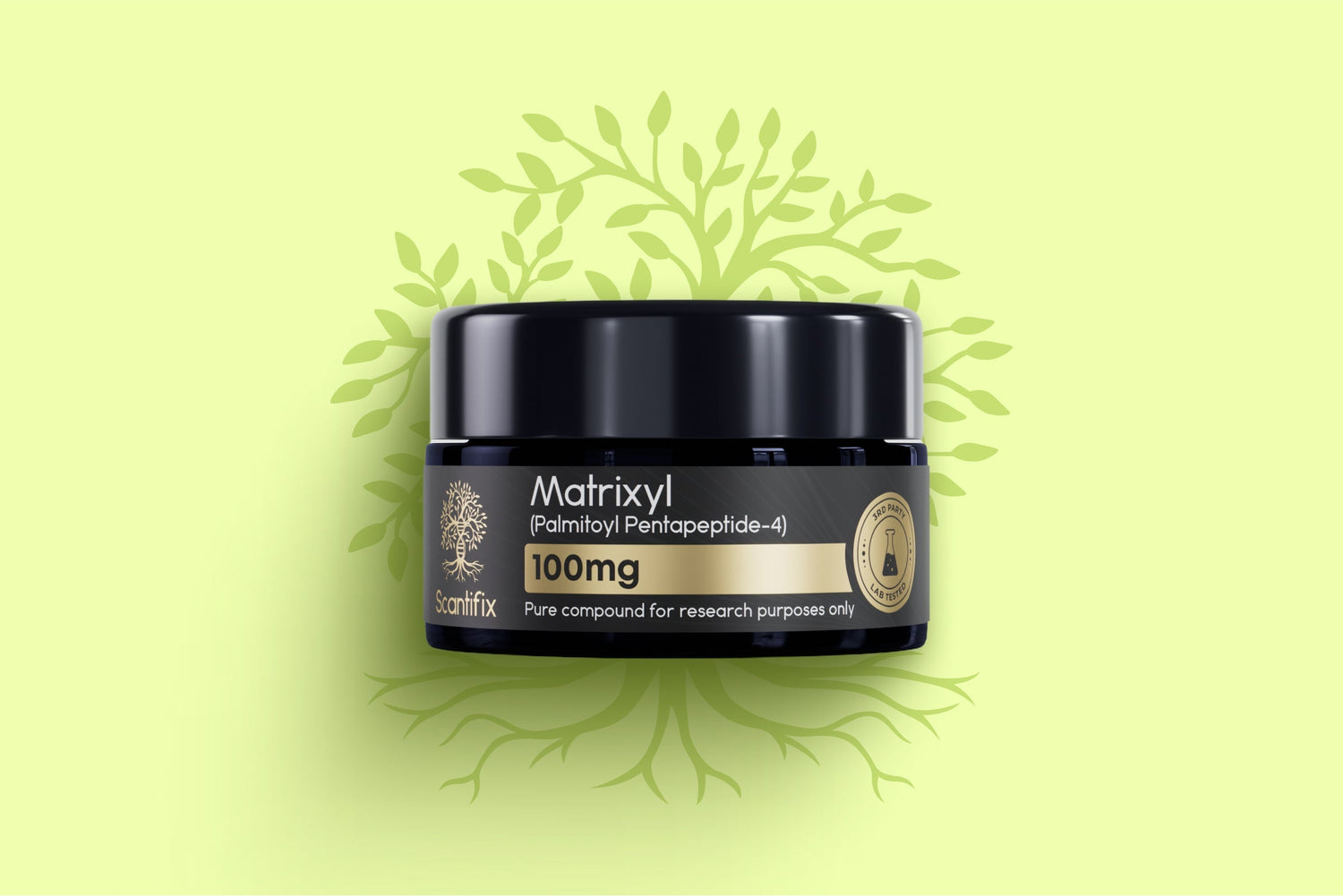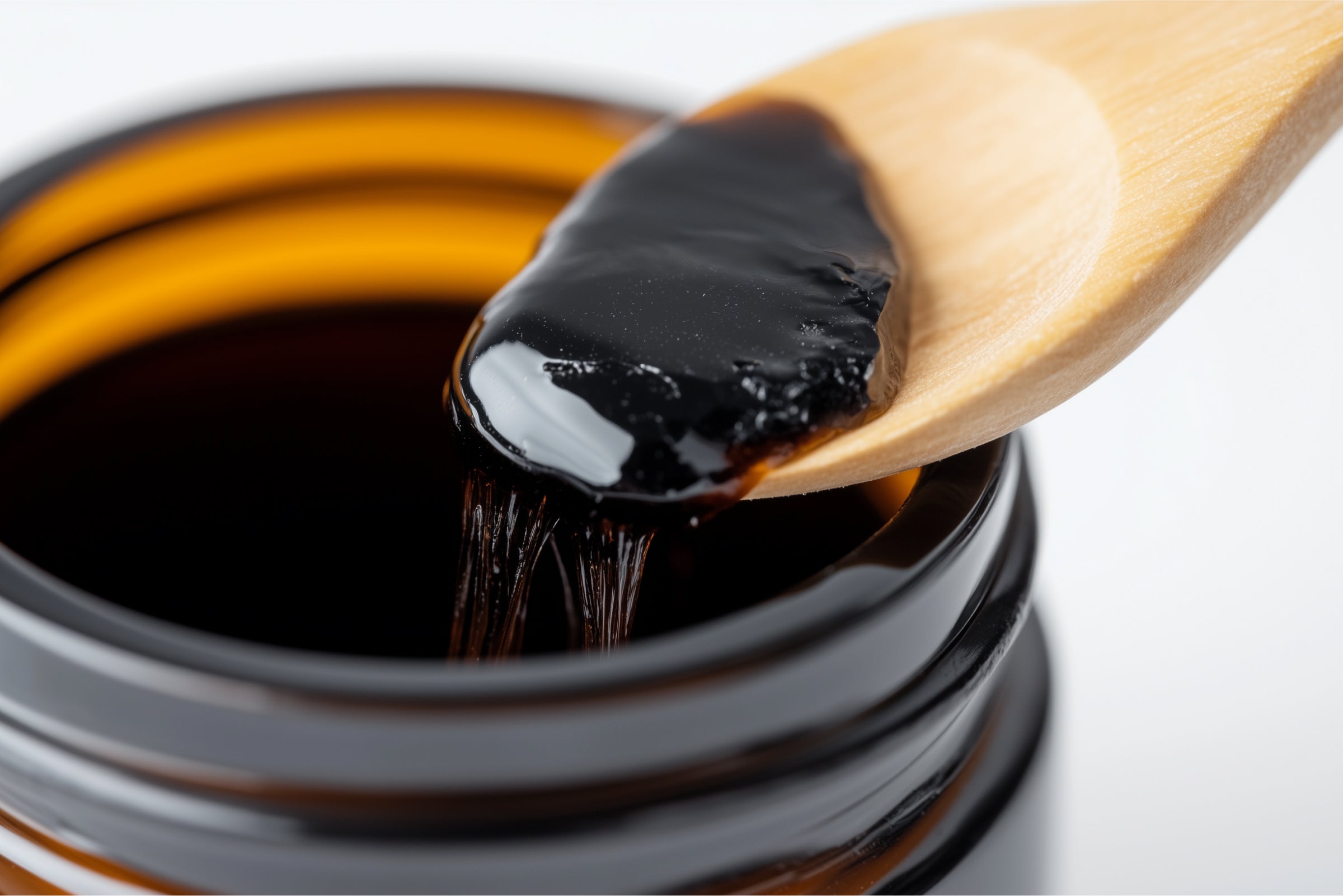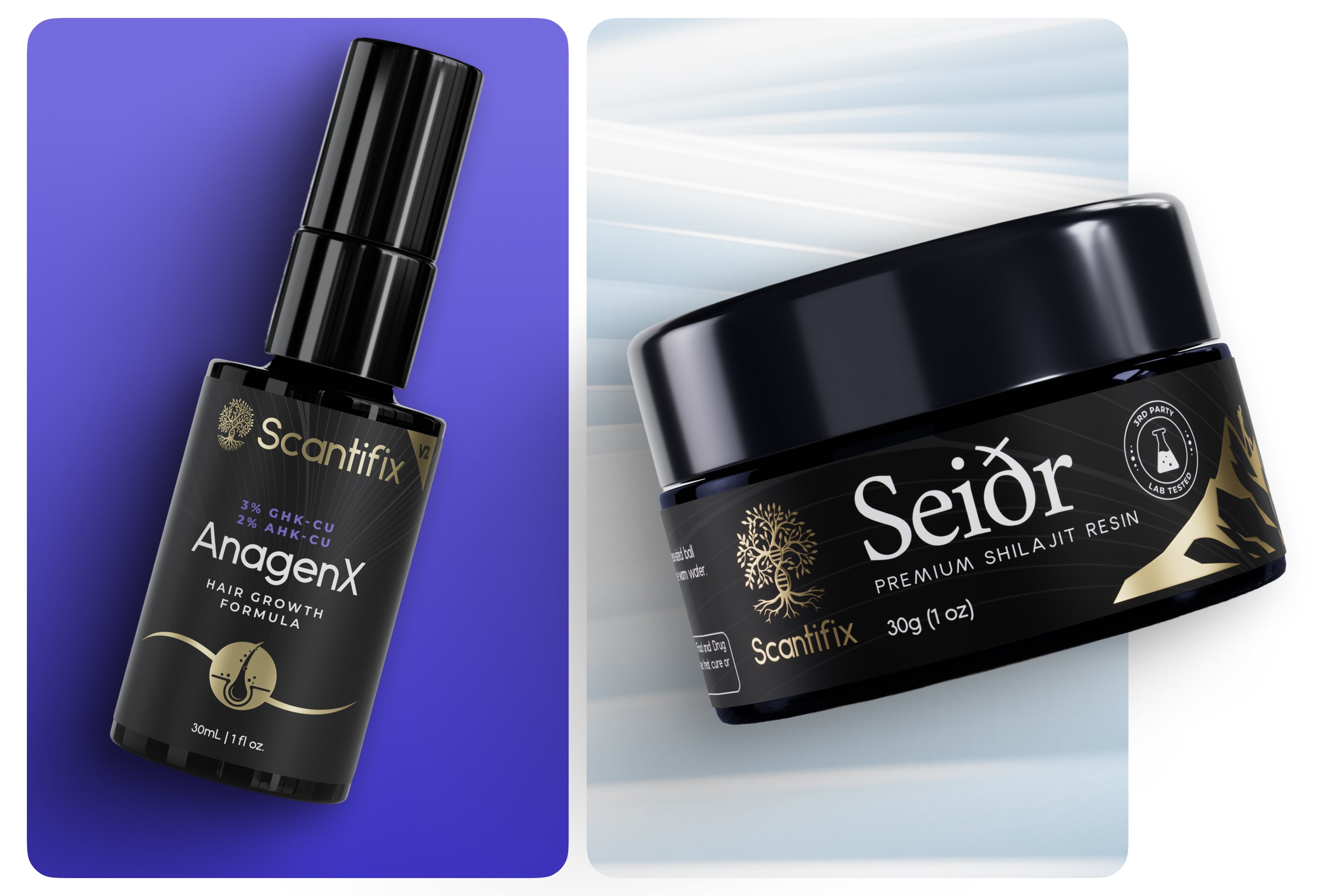One of the earliest signs of aging skin is a steady decline in collagen. Collagen is the structural protein that gives skin its firmness, bounce, and smooth surface. As it breaks down, fine lines become more noticeable, elasticity diminishes, and skin starts to feel less resilient.
Among the many ingredients developed to address this, peptides stand out because they work with the skin’s own biology rather than forcing results through irritation or abrasion. One peptide in particular, Matrixyl (Palmitoyl Pentapeptide-4), has become a cornerstone in topical formulations aimed at restoring firmness and reducing visible wrinkles. It works by signaling the skin to repair itself, encouraging collagen and elastin production where real change occurs in the skin (Schagen, 2017).
Let’s take a closer look at what Matrixyl is, how it works, and why it continues to be such a trusted tool in modern anti-aging skincare.
What Is Matrixyl?
Matrixyl is the trade name for Palmitoyl Pentapeptide-4, a short chain of five amino acids chemically linked to palmitic acid. The palmitic acid has an important role: it helps the peptide penetrate the skin’s lipid-rich outer layers so that it can reach the cells it’s designed to influence.
What makes Matrixyl unique is how it mimics the fragments of collagen that naturally occur when collagen breaks down. In healthy, younger skin, these fragments act as messengers, signaling fibroblasts (the cells responsible for producing structural proteins) to start making more collagen. With age, that signaling slows. Matrixyl steps in to replicate the message. It essentially tells the skin that it’s time to rebuild (Ferreira et al., 2020).
How Matrixyl Works in the Skin
The skin is constantly remodeling itself, balancing breakdown and repair. As collagen degrades, small fragments are released that stimulate fibroblasts to produce more. This feedback loop is vital for keeping skin strong and elastic.
Matrixyl taps directly into this system by acting as a messenger peptide. Because its amino acid sequence resembles a fragment of collagen, fibroblasts recognize it and respond by:
-
- Increasing collagen synthesis — particularly Type I and III collagen, the types most associated with firmness and elasticity (Pintea et al., 2025).
- Supporting elastin production, which improves the skin’s ability to stretch and rebound (Mao, 2025).
- Boosting hyaluronic acid synthesis, contributing to hydration and plumpness (Mao, 2025).
- Reinforcing the extracellular matrix, the structural network that keeps skin smooth and resilient (Schagen, 2017).
Matrixyl works in the dermis, the deeper layer of skin where structural proteins such as collagen and elastin are built and maintained, supporting long-term structural resilience.
Benefits of Matrixyl in Skincare
Extensive research highlights Matrixyl’s ability to meaningfully improve the look and feel of aging skin, confirming its role as one of the most reliable collagen-supporting peptides available.
1. Reduction of Fine Lines and Wrinkles
One of the most documented benefits of Matrixyl is its ability to minimize the appearance of wrinkles. In a double-blind, placebo-controlled study, participants using a Matrixyl cream for several months saw measurable reductions in wrinkle depth and surface area compared to placebo groups. These improvements weren’t instant, but they were gradual and cumulative, which reflects the skin’s natural process of rebuilding (Suhendra, 2020).
2. Improved Firmness and Elasticity
By encouraging collagen and elastin production, Matrixyl helps restore the skin’s structure. People often notice their skin feels firmer and more lifted, a change that clinical tests of elasticity have also confirmed (Benetti et al., 2023).
3. Enhanced Hydration and Plumpness
Collagen and hyaluronic acid work together to hold water in the skin. By signaling increased synthesis of both, Matrixyl supports better moisture retention. The result is skin that not only looks fuller but also feels softer and more supple (Mao, 2025).
4. Gentle and Well-Tolerated
Unlike treatments that rely on exfoliation or controlled irritation, Matrixyl works with the skin’s signaling systems. That makes it suitable even for sensitive or reactive skin, with very low risk of irritation (Suhendra, 2020).
Matrixyl Compared to Other Peptides for Anti-Aging Skincare
Peptides are not interchangeable, with each one having a distinct mechanism and role. Comparing Matrixyl with other popular peptides shows how it fits into the broader picture of anti-aging strategies.
Matrixyl vs. Argireline / SNAP-8
Argireline and SNAP-8 are neuromodulatory peptides. They work by limiting the release of acetylcholine, the neurotransmitter that signals facial muscles to contract. This reduces the repetitive movements that deepen expression lines over time.
Matrixyl, by contrast, doesn’t act on muscle contractions at all. Its focus is structural: stimulating collagen and elastin to rebuild the skin’s foundation. When used together, they complement one another. Argireline and SNAP-8 soften expression lines from the “movement” side, while Matrixyl strengthens the skin itself.
Matrixyl vs. Syn-Coll
Syn-Coll is another collagen-supporting peptide. Like Matrixyl, it stimulates fibroblasts to produce collagen, but it also helps inhibit enzymes that break collagen down. The two share a similar goal but through slightly different pathways. Matrixyl is often seen as the more established, foundational peptide, while Syn-Coll adds an additional protective angle.
Matrixyl vs. GHK-Cu
GHK-Cu, a copper-bound tripeptide, is best known for its regenerative and wound-healing properties. It also stimulates collagen, but its actions are broader, supporting angiogenesis (formation of new blood vessels) and anti-inflammatory pathways. Matrixyl is more targeted to collagen and extracellular matrix repair, making it highly focused on structural anti-aging.
Understanding Matrixyl’s unique benefits, as well as how it compares with other anti-aging peptides, is essential to choosing the right approach. The best option depends on each person’s individual needs and priorities for their skin. If Matrixyl seems like the right fit, there are multiple ways to incorporate it into a routine—either on its own or alongside complementary peptides and ingredients.
Matrixyl in Skincare Products
One reason Matrixyl is so widely used is its versatility. It’s stable, water-soluble, and effective at relatively low concentrations, which makes it suitable for different product formats (Ferreira et al., 2020).
Raw Matrixyl and Custom Blends
Matrixyl is available in lyophilized (freeze-dried) powder form, ideal for formulators, researchers, or DIY users. When reconstituted in a compatible carrier, it can be added to custom serums or creams, giving complete control over concentration and combinations.
For best results, mix raw Matrixyl with your preferred water-based carrier, such as a hyaluronic acid serum or another compatible base. Matrixyl can be a little tricky to dissolve, so using a small mixer or frother and mixing in a glass can help achieve a smooth consistency without lumps.
Once prepared, it combines well with other supportive actives. It pairs especially well with humectants for hydration, niacinamide for barrier support, and complementary peptides for layered anti-aging benefits.
Professional Serums and Creams
Many anti-aging products on the market feature Matrixyl as a key ingredient. These ready-made formulas often pair it with hydrators like hyaluronic acid, antioxidants like vitamin C, or barrier-strengthening ingredients like ceramides for a more complete approach. They can be a good choice for those who want a convenient, ready-to-use option, but it’s important to do your research and select products that are transparent about their ingredients and meet high standards of quality.
What to Look for in High-Quality Matrixyl Products
Not all peptide products are created equally. If you’re exploring Matrixyl as a raw ingredient or in finished formulations, quality matters.
-
- Purity: Look for high purity levels, verified by third-party testing.
- Transparency: Trustworthy products provide Certificates of Analysis (COAs) so you know exactly what you’re getting.
- Formulation: Avoid unnecessary fillers, synthetic fragrances, or alcohols that can undermine results.
- Packaging: Because peptides can degrade with light and heat, protective containers like violet or amber glass help maintain potency.
In an industry where too many brands are cutting corners with unnecessary additives and low purity or barely-there active ingredients, it can feel daunting to find products you can trust. But there are some companies dedicated to doing things differently if you know what to look for.
Enhancing Results with Synergistic Strategies
A high-quality Matrixyl product is effective on its own, but certain treatments can amplify its results by improving absorption or stimulating similar pathways.
-
- Microneedling: Creates micro-channels in the skin that enhance penetration of active ingredients. When combined with Matrixyl serums, this can accelerate collagen-supportive effects.
- Red Light Therapy: Uses wavelengths of visible red and near-infrared light to stimulate fibroblast activity and boost collagen synthesis. When paired with Matrixyl, it creates a supportive environment for structural repair.
- Peptide Synergy: Matrixyl can be combined with GHK-Cu, Syn-Coll, or neuromodulatory peptides like Argireline for a multi-pathway approach to anti-aging.
Together, these strategies create a layered approach to skincare, helping Matrixyl deliver even greater visible improvements and preparing the ground for a complete routine.
Final Thoughts
Matrixyl is a scientifically recognized peptide that works with the skin’s own biology to restore structure and resilience (Skibska & Perlikowska, 2021). By signaling fibroblasts to produce collagen, elastin, and hyaluronic acid, it addresses some of the most fundamental processes behind skin aging.
What makes Matrixyl valuable is its combination of scientific credibility, proven results, and gentle action. It doesn’t rely on irritation or drastic interventions, but instead encourages the skin to do what it already knows how to do: repair itself. For those seeking smoother texture, reduced wrinkles, and firmer skin over time, Matrixyl remains a trusted and versatile choice.
Ready to give it a try for yourself? Shop high-purity, 3rd-party tested, raw peptides that you can trust from Scantifix.
Resources
Benetti, A. A., Tarbox, T., & Benetti, C. (2023). Current insights into the formulation and delivery of therapeutic and cosmeceutical agents for aging skin. MDPI. https://www.mdpi.com/2079-9284/10/2/54
Ferreira, M. S., Magalhães, M. C., & Sousa-Lobo, J. M. (2020). Trending anti-aging peptides. MDPI. https://www.mdpi.com/2079-9284/7/4/91
Mao, Z. (2025). Frontiers in skin rejuvenation: Recent advances in anti-aging skincare technologies based on proteins, peptides, and peptide derivatives. Modern Health Science, 8(1), 69–77. https://j.ideasspread.org/index.php/mhs/article/view/660
Pintea, A., Manea, A., Pintea, C., Vlad, R. A., & Bîrsan, M. (2025). Peptides: Emerging candidates for the prevention and treatment of skin senescence: A review. MDPI Biomolecules, 15(1), 88. https://www.mdpi.com/2218-273X/15/1/88
Schagen, S. K. (2017). Topical peptide treatments with effective anti-aging results. Cosmetics, 4(2), 16. https://www.mdpi.com/2079-9284/4/2/16
Skibska, A., & Perlikowska, R. (2021). Signal peptides—Promising ingredients in cosmetics. Current Pharmaceutical Design, 27(22), 2630–2639. https://www.eurekaselect.com/article/117309
Suhendra, N. N. (2020). The efficacy of 7% palmitoyl pentapeptide-4 serum for the periorbital wrinkle reduction. Rangsit Graduate Research Conference. https://rsujournals.rsu.ac.th/index.php/rgrc/article/view/1792






Leave a comment
All comments are moderated before being published.
This site is protected by hCaptcha and the hCaptcha Privacy Policy and Terms of Service apply.